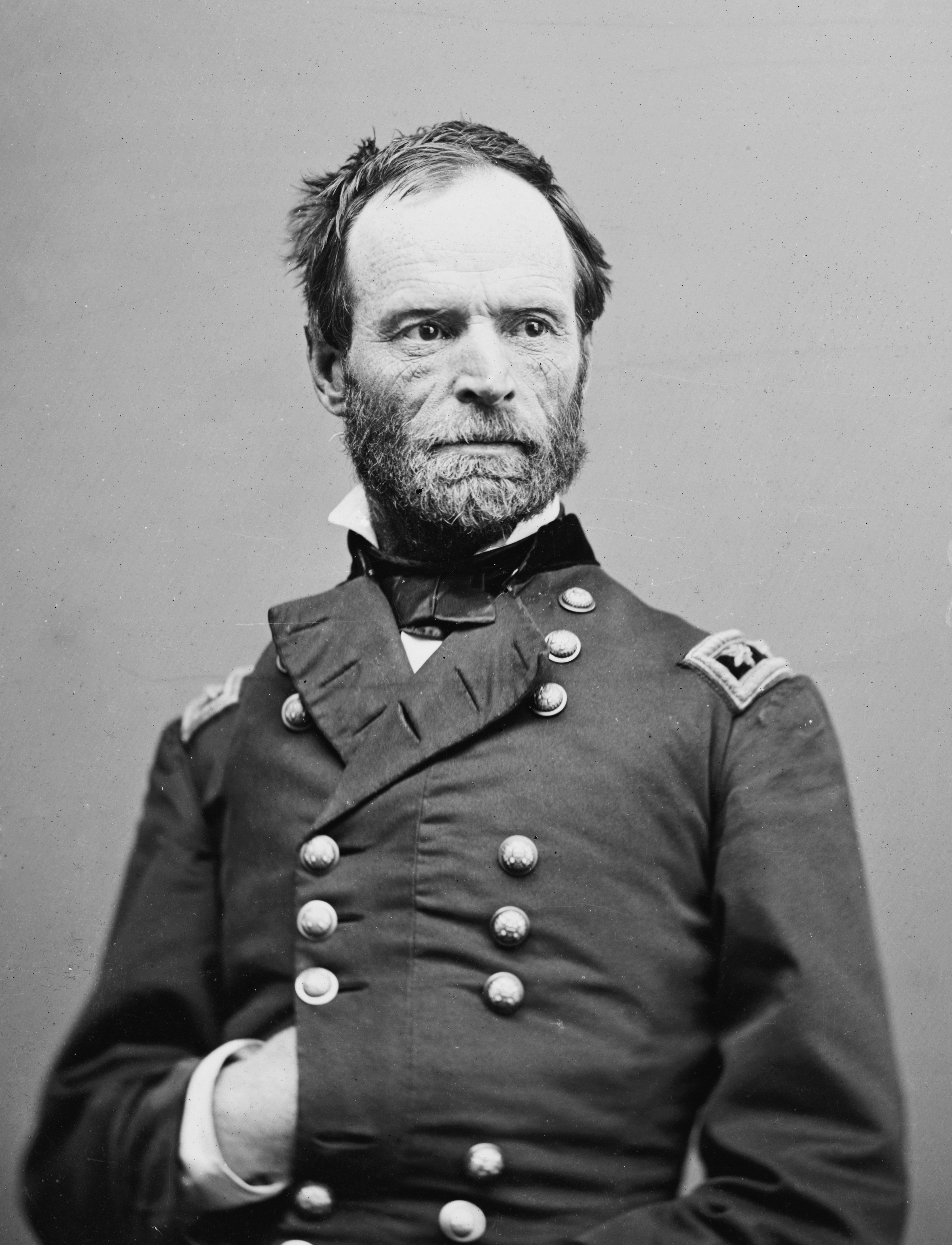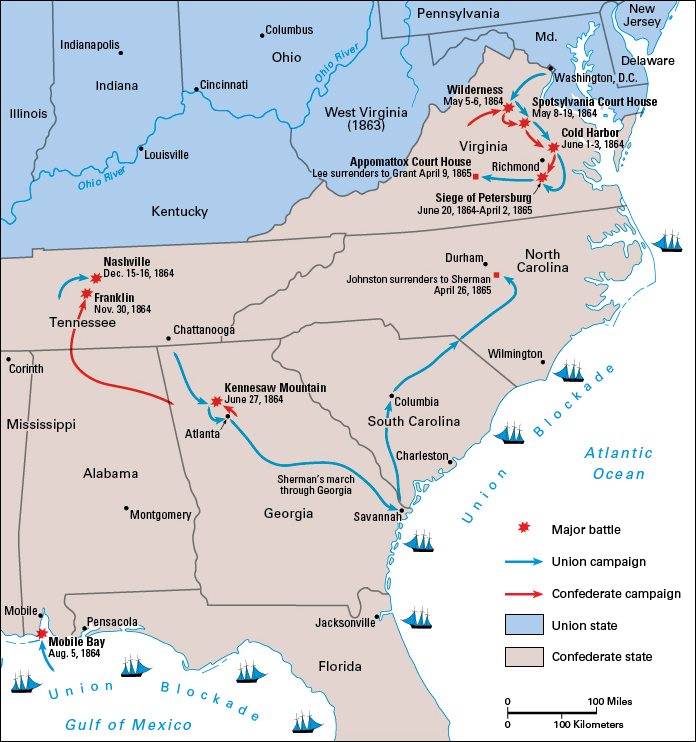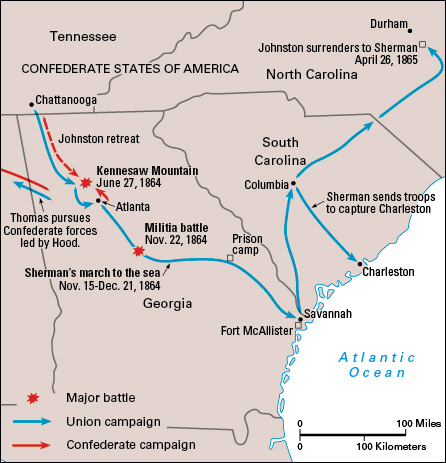Atlanta campaign was an important campaign during the American Civil War (1861-1865). It took place in northeastern Georgia from May to September 1864. Union forces led by General William T. Sherman captured Atlanta that September.
Background.
In March 1864, President Abraham Lincoln promoted Ulysses S. Grant to lieutenant general and gave him command of all Northern armies. Grant ordered Sherman to advance into Georgia and seize Atlanta, an industrial and railroad center of the Confederacy. While Sherman headed for Atlanta, Grant and General George Meade attacked General Robert E. Lee’s Confederate army in Virginia. Grant hoped that the two simultaneous operations would prevent the Confederate armies from reinforcing each other, and that the Northern forces would use their superior resources to defeat the South.

Sherman’s troops were divided into three armies. General George H. Thomas commanded about 60,000 men, General James B. McPherson about 24,500, and General John Schofield about 13,500. Opposing Sherman were about 45,000 Confederate troops led by General Joseph E. Johnston. Johnston soon would be reinforced with about 15,000 more men commanded by General Leonidas Polk.
Sherman vs. Johnston.
On May 4, 1864, Sherman left his base at Chattanooga, Tennessee, and headed into Georgia, toward Atlanta. While the rest of the Union army held Johnston’s forces near Dalton, northwest of Atlanta, McPherson’s army marched around Johnston’s western flank (side) to cut the railroad supply line. Near Resaca, south of Dalton, McPherson met a Confederate force much smaller than his own. However, McPherson overestimated the size of the force and pulled back. When Johnston heard about McPherson’s troops, he withdrew to Resaca. From May 13 to May 15, the two sides fought an indecisive battle there.
After the battle, Sherman again sent part of McPherson’s army around Johnston’s western flank to cut the supply line. When Johnston learned of the move, he withdrew from Resaca and headed south toward Cassville. Johnston set a trap to attack Schofield’s army before the rest of Sherman’s army could come to its aid. However, due to faulty information, Johnston called off the attack and, instead, retreated about 10 miles (16 kilometers).
Sherman felt that Johnston’s position was too strong to attack and, once again, went around Johnston’s western flank and headed for Dallas, Georgia. Johnston found out about Sherman’s maneuvers and was able to build fortifications there before the Union force arrived. From May 25 to 28, the two sides fought a series of brutal battles near Dallas.
Both sides then moved East toward Marietta. On June 14, General Polk was killed by Union artillery while scouting the Union position. On June 27, Sherman attacked Johnston’s entrenched troops at the Battle of Kenesaw (now Kennesaw) Mountain. Union troops were pushed back and suffered about 3,000 casualties. The Confederates suffered only about 500. After the battle, Sherman pushed Johnston south to the Chattahoochee River. Sherman sent troops around Johnston’s flank, and Johnston was forced to retreat to Atlanta. Confederate President Jefferson Davis decided that Johnston was fighting too cautiously. On July 17, Davis replaced Johnston with General John B. Hood.

Sherman vs. Hood.
When Hood took command of the Southern army, Sherman and his three armies were all moving toward Atlanta. On July 20, Hood attacked Thomas’s army north of Atlanta at the Battle of Peachtree Creek. Hood’s army suffered more casualties than the Union and was forced to fall back.
Two days later, Hood met McPherson’s army at the Battle of Atlanta, east of the city. The Confederates suffered about twice as many casualties as the Union. However, the Confederates killed McPherson when he refused to surrender after accidentally riding into the Confederate lines.
Sherman replaced McPherson with General Oliver Howard. He sent Howard and his troops around northern Atlanta to attack the city from the west. On July 28, Howard’s army defeated the Confederates at the Battle of Ezra Church. Again, the Confederates suffered many more casualties than the Union.
Throughout the remainder of July and August, Sherman’s army continued to move south to cut Hood’s railroad supply line. On August 31, Union troops defeated the Confederates at the Battle of Jonesboro, about 15 miles (24 kilometers) south of Atlanta. To avoid becoming completely surrounded, Hood evacuated Atlanta on September 1. Sherman occupied it the next day and telegraphed Washington, D.C.: “Atlanta is ours, and fairly won.”
Aftermath.
Sherman’s victory was not as complete as it seemed. Hood’s army escaped and began hit-and-run raids on Sherman’s communications with Chattanooga. Sherman sent Thomas back to Tennessee to deal with Hood and his men. In December, Thomas would practically destroy Hood’s army at the Battle of Nashville, Tennessee.
On November 15, Sherman and about 62,000 troops left Atlanta and began “Sherman’s March” through Georgia and the Carolinas.

See also Civil War, American ; Hood, John Bell ; Johnston, Joseph Eggleston ; Sherman, William Tecumseh ; Sherman’s March .
